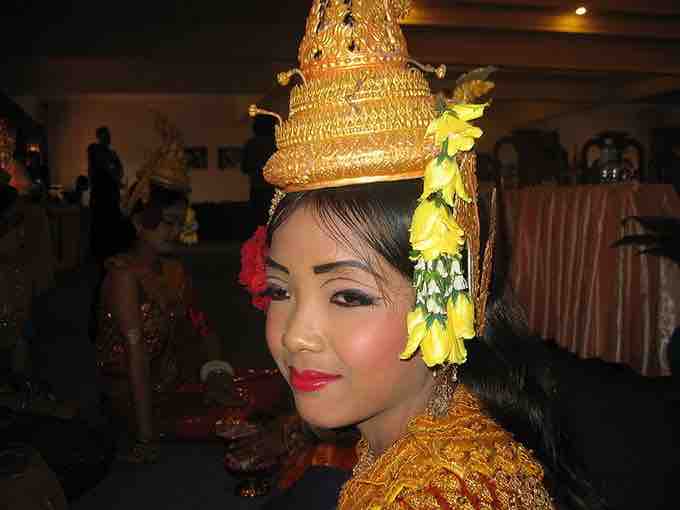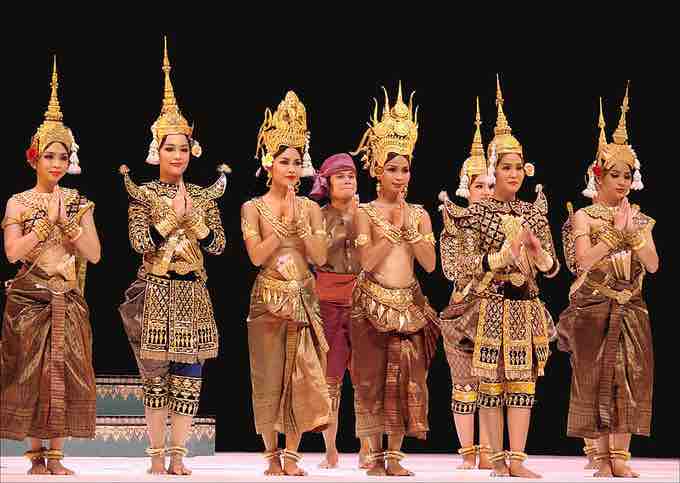Introduction: Cambodia
Throughout Cambodia's long history, religion has been a major source of cultural inspiration. Over nearly two thousand years, Cambodians have developed a unique Khmer belief from the syncreticism of indigenous animistic beliefs and the Indian religions of Buddhism and Hinduism. Indian culture and civilization, including its languages and arts, reached mainland Southeast Asia around the 1st century CE; it is generally believed that seafaring merchants brought Indian customs and culture to ports along the Gulf of Thailand and the Pacific en route to trade with China. The Kingdom of Funan was most probably the first Khmer state to benefit from this influx of Indian ideas.
Art in Cambodia
Architecture
The history of Cambodian art stretches back centuries to ancient times, but the most famous period is undoubtedly the Khmer art of the Khmer Empire (802–1431). The 12th century temple complex of Angkor Wat, located amidst other sites in the area around Angkor, it perhaps the most famous example of Cambodian architecture. After the collapse of the Khmer Empire, this and other sites were abandoned and overgrown, allowing much of the era's stone carving and architecture to survive to the present day.
Angkor Wat was originally constructed as a Hindu temple of god Vishnu for the Khmer Empire, gradually transforming into a Buddhist temple toward the end of the 12th century. The temple combines two basic plans of Khmer temple architecture: the temple-mountain and the later galleried temple. It is designed to represent Mount Meru, home of the devas in Hindu mythology: within a moat and an outer wall 2.2 miles long are three rectangular galleries, each raised above the next. At the center of the temple stands a group of towers. Unlike most Angkorian temples, Angkor Wat is oriented to the west; scholars are divided as to the significance of this. The temple is admired for the grandeur and harmony of the architecture, its extensive bas-reliefs, and the numerous devatas, or Hindu deities, adorning its walls.
Angkor Wat
The front side of the main complex of Angkor Wat.
Traditional Arts
In pre-colonial Cambodia, art and crafts were generally produced either by rural non-specialists for practical use or by skilled artists producing works for the Royal Palace. Cambodia's best-known stone carving adorns the temples of Angkor. Silk weaving has a long history, with the practice dating back as early as the 1st century; textiles were often used in trade during Angkorian times. Many Cambodian farmers would weave baskets out of thinly cut bamboo for household use or to sell as a supplemental source of income.
The height of Cambodian traditional lacquerware was between the 12th and 16th centuries; some examples of work from this era, including gilded Buddha images and betel boxes, have survived to the present day. Lacquerware was traditionally colored black using burnt wood, representing the underworld; red using mercury, representing the earth; and yellow using arsenic, representing the heavens. Lacquer on Angkorian stone dates to the 15th or 16th century. Silversmithing in Cambodia also dates back centuries, and the Royal Palace traditionally patronized silversmiths' workshops. Silver was made into a variety of items, including weaponry, coins, ceremonial objects used in funerary and religious rituals, and betel boxes. During Cambodia's colonial period, artisans at the School of Fine Art produced celebrated silverwork, and by the late 1930s there were more than 600 silversmiths.
Cambodian pottery traditions date to 5000 BCE. Ceramics were mostly used for domestic purposes such as holding food and water, and shapes such as birds, elephants, rabbits, and other animals were popular between the 11th and 13th centuries. Cambodia's kite-making and kite-flying tradition, which dates back many centuries, was revived in the early 1990s and is now extremely popular throughout the country. Kites are generally flown at night during the northeast monsoon season; a bow attached to the kites resonates in the wind, producing a musical sound.
Beginning in the mid-20th century, a tradition of modern art began in Cambodia, though in the later 20th century both traditional and modern arts declined for several reasons, including the killing of artists by the brutal Khmer Rouge regime. The country has experienced a recent artistic revival due to increased support from governments, NGOs, and foreign tourists.
Dance
Dance in Cambodia consists of three main categories:
- Classical dance of the royal court used for invocation, for entertainment, and to pay homage;
- Folk dance, which portrays cultural traditions; and
- Social dances performed in social gatherings.
Cambodia's premiere performing art form is the Khmer classical dance, or Robam Preah Reach Trop. It is a highly stylized dance form originating from the royal courts. Performances of classical dance consist of elaborately costumed dancers and music played by a pinpeat ensemble. It is performed for invocation of deities and spirits as well as to pay homage to royalty and guests. In the mid-20th century, it was introduced to the general public and became widely celebrated as iconic of Cambodian culture. It was often performed during public events, holidays, and for tourists visiting Cambodia. Two of the most performed classical dances are the Robam Chun Por ("Wishing dance") and the Robam Tep Apsara ("Apsara dance").

Khmer Dancer
Lady dancer in Siem Reap.
Music
Modern music in Cambodia is derived both from traditions dating back to the ancient Khmer Empire and from the rapid Westernization of the popular music scene in modern times. Cambodian Art music is highly influenced by ancient forms as well as Hindu forms. Religious dancing, many of which depict stories and ancient myths, are common. Cambodian pop music, or modern music, is divided into two categories: ramvong, a slow dance music, and ramkbach, which is closely related to Thai folk music. In the Siem Reap province, a form of music called kantrum has become popular; originating among the Khmer Surin in Thailand. Kantrum is famous for Thai and Cambodian stars like Darkie.

Royal Ballet of Cambodia
The Royal Ballet of Cambodia at curtain call. This was a performance of a dance drama titled 'Apsara Mera' in Paris, France.